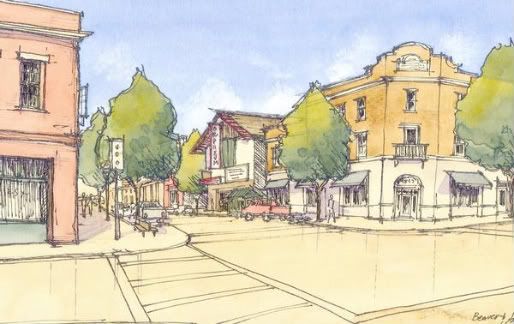Newly proposed form-based zoning codes aimed at preserving downtown Flagstaff's historic character would be incentivized with eased parking requirements and streamlined approval processes:

A few new buildings line Aspen Avenue in an artist's rendering of what downtown
Flagstaff could look like in the future if a new, optional zoning is passed for the city's urban core.
(render: Opticos Design)
New code shows good Flag form
Reaction is largely positive to the rollout of a new approach to zoning in Flagstaff that emphasizes form over function
By JOE FERGUSON
Sun Staff Reporter
Sunday, October 11, 2009
Steve Vanlandingham was one of 30 residents who spent their Friday night listening to city planners and hired consultants propose a new type of zoning for downtown Flagstaff. The downtown property owner was an unlikely person to spend any time inside Flagstaff City Hall -- he swore off any redevelopment of his properties more than a decade ago. He said dealing with the city's planning staff had become extremely frustrating as they were resistant to any of his plans. "I literally threw up my hands in 1997," Vanlandingham said. "I just had enough."
But something about a new type of optional zoning the city is planning for downtown, along with the Southside, Old Townsite and north downtown neighborhoods, was enough to change Vanlandingham's mind. He said the proposed
form-based codes, which focus on the shape, mass and look of buildings rather than the underlying land use of the property, was appealing. Many developers have long complained that the city's current planning process is relatively arbitrary -- that every city planner interprets the city's codes differently.
NO MORE ONSITE PARKING
Roger Eastman, the city's zoning code administrator who is overseeing the overhaul, said the form-based codes will encourage incremental changes in the city's urban core while preserving its historic character. He uses the former home of Odegaard's Sewing Center on the corner of West Aspen Avenue and North Beaver Street as an example of how the new zoning could work. The commercial building is a bit of a throw-back to older zoning requirements, with setbacks and onsite parking. Under the new proposed zoning codes, which have not been approved by the Flagstaff City Council, a developer could conceivably erect a three-story building covering most of the property, including over the existing parking lot, in exchange for following the form-based codes. The current zoning would not allow for such a large building because the owner would likely need to provide for more on-site parking, not less.
But Eastman said a form-based code would not require on-site parking if the downtown parking plan includes a parking garage. He said
the city can offer incentives like less parking, smaller setbacks and a streamlined approval process to encourage developers to use the form-based codes. Eastman points out that even if the proposed zoning is approved by the City Council, it would be entirely optional for property owners. A state law passed in 2006, better known as Prop 207, has made the city of Flagstaff reluctant to rezone private property without the owner's consent. The law requires cities to compensate property owners for any value lost due to new regulations. Property owners could continue to use the underlying zoning already in place for any development plans, Eastman said.
HISTORIC CHARACTER PARAMOUNT
Charlotte Welch, who lives north of downtown, sees the proposed form-based codes in an entirely different light. The retired planner remained suspicious of the city's intent, contending the city was far more interested in redeveloping downtown Flagstaff than it was in preserving its historic character -- one of the city's stated goals for the new zoning overlay. "All they were talking about is tearing [historic properties] out," Welch said. "We will lose what we have." Welch's biggest concern is that any new development will lead to new commercial businesses in the neighborhood she lives, which she has fought to protect. Last year, she led the fight against the city's plan to allow downtown employees to park temporarily in the neighborhood.
Eastman said Welch's concerns were misplaced, saying the overlay would strengthen protections against building new commercial structures in Welch's neighborhood. "There will be no new commercial building in her neighborhood," Eastman said.
"The intent of the form-based codes is to build upon the historic character of the neighborhoods downtown."
CONSULTANTS TO FOLLOW UP
Eastman said the consultants will give a follow-up presentation to several city commissions as well as the City Council in a few months. The presentation will incorporate the suggestions from the more 300 people who attended a series of public meetings held last week. After the preliminary draft has been discussed and reviewed by city staff and members of the community, the consultant is expected to prepare a finalized version to be reviewed and voted on by the city's Planning and Zoning Commission and Council.